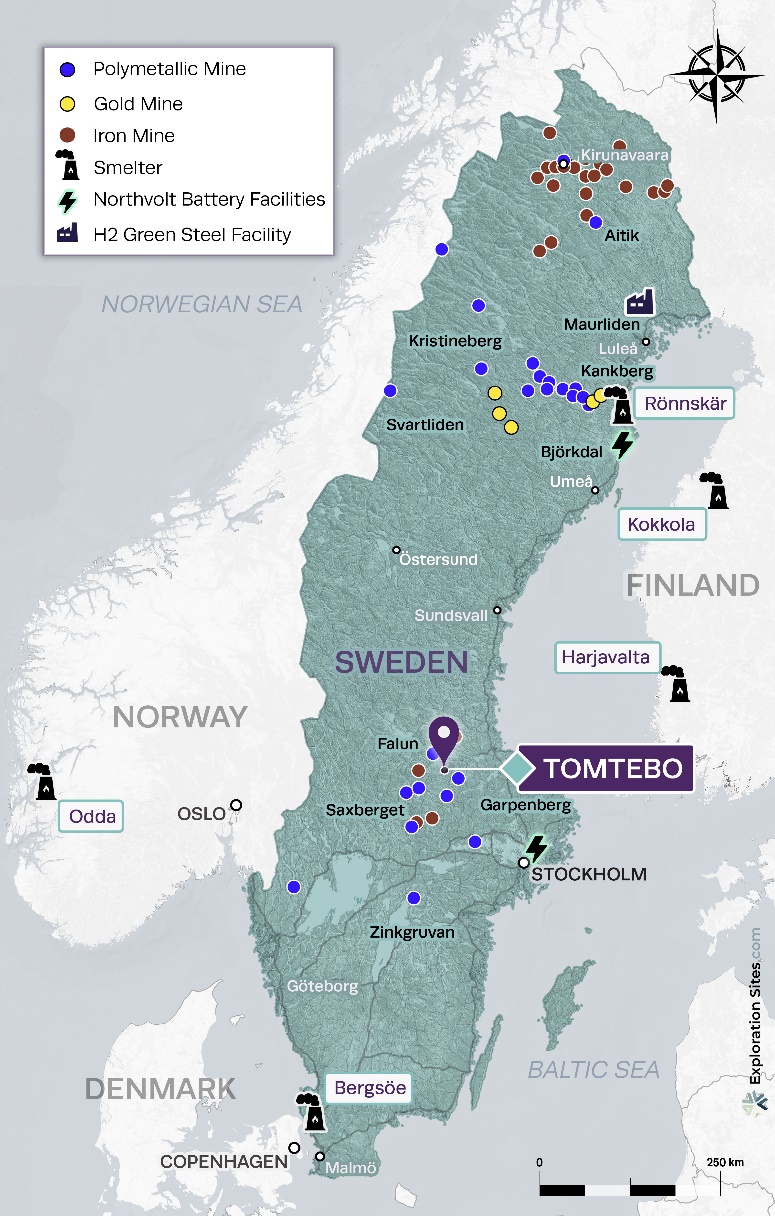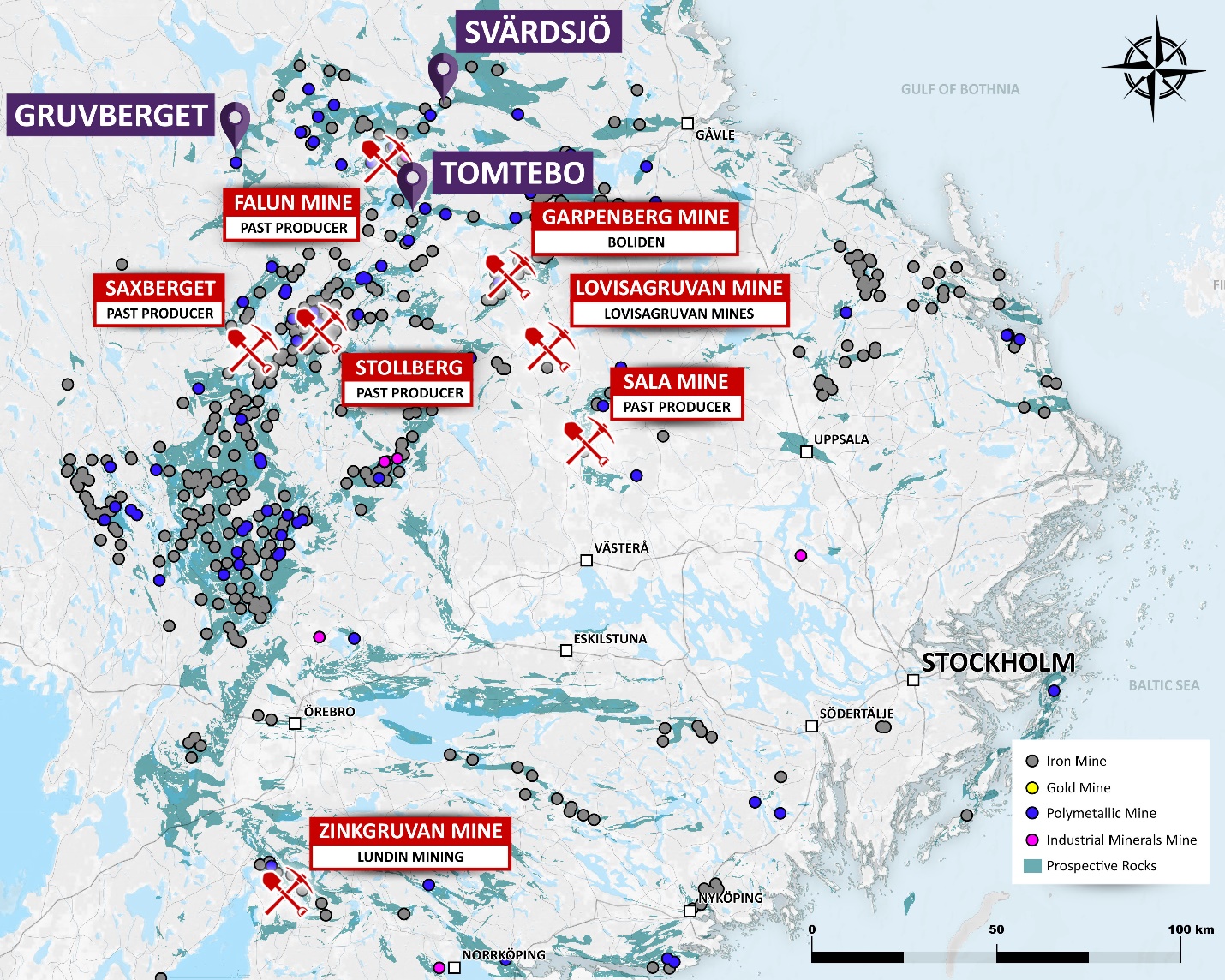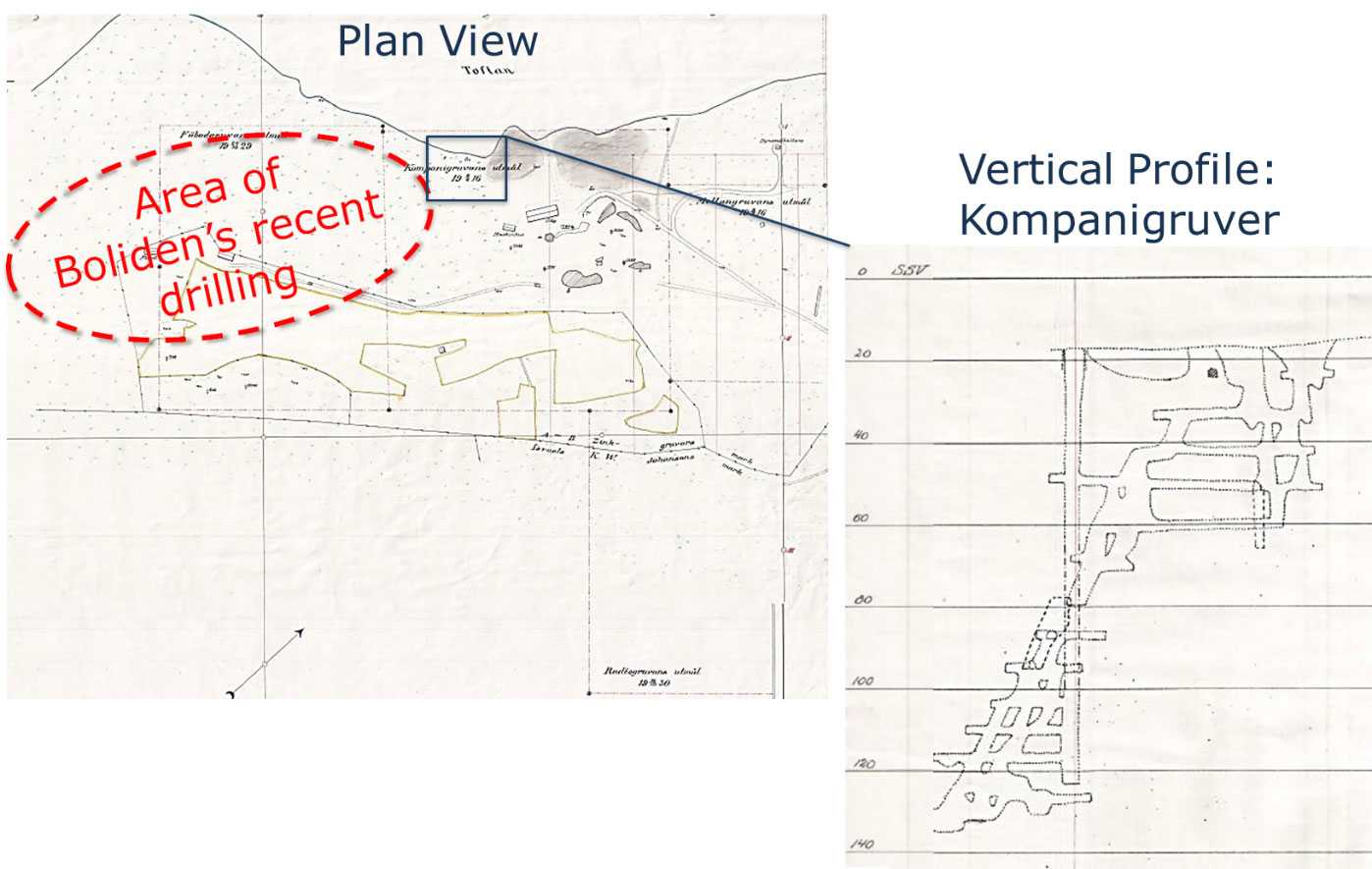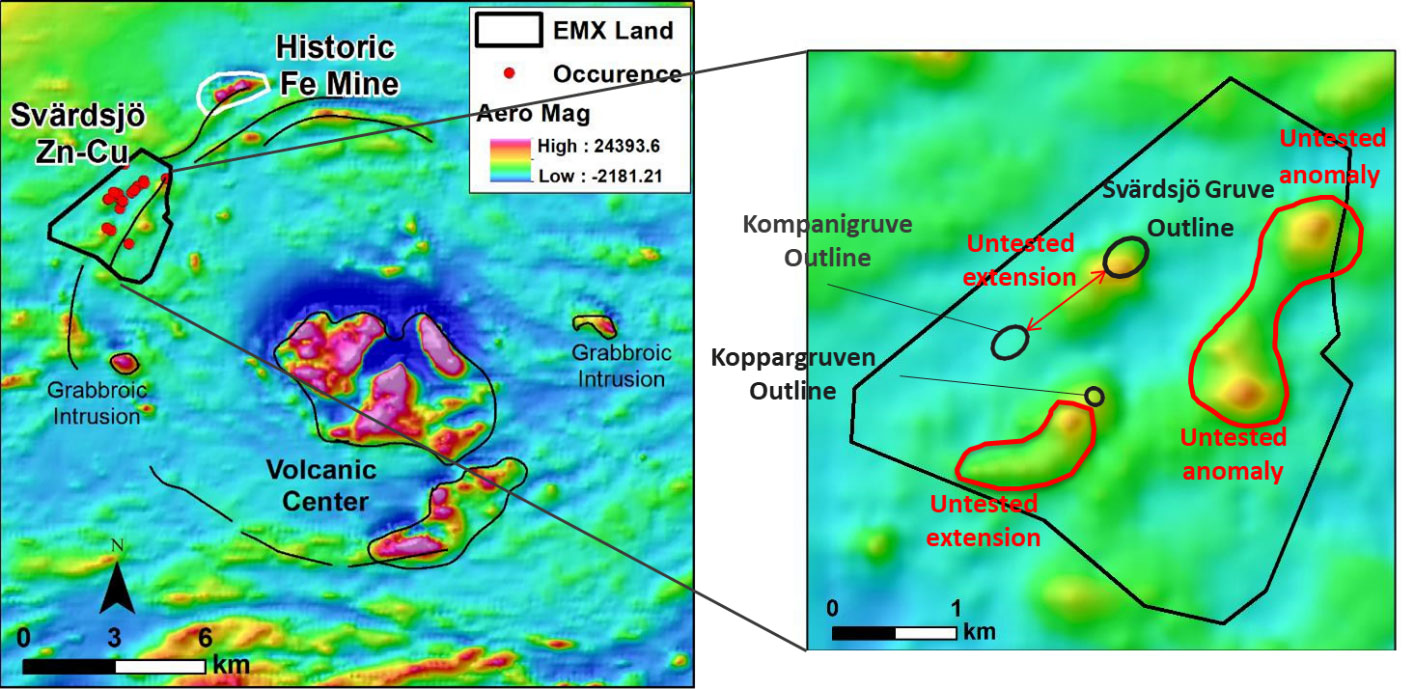Overview
In July 2021, District Metals acquired 100% of the Svärdsjö Property located in the prolific Bergslagen Mining District of south central Sweden from EMX Royalty Corp. (TSX-V:EMX). The Bergslagen is known for world class polymetallic mines such as Boliden’s Garpenberg and Lundin Mining’s Zinkgruvan. The size and scale of these mines has only been revealed within the last two decades through a better understanding of the associated polymetallic VMS/SedEx mineralizing systems, and through advances in drilling and mining technology.
Svärdsjö is an advanced exploration property with the following highlights:
- Svärdsjö covers an area of 1,037 ha, and is located approximately 200 km northwest from the capital city of Stockholm in Sweden.
- Boliden’s Garpenberg Mine is located 45 km to the southeast, and the historic Falun Mine is located 17 km to the southwest. Lundin’s Zinkgruvan Mine is located 200 km to the southwest.
- Svärdsjö is located 25 km to the north of Tomtebo, and contains similar host rocks, structure, alteration, and mineralization styles as the Garpenberg Mine, Historic Falun Mine, and the Tomtebo Property.
- Several historic mines, numerous mineralized prospects and multiple untested targets are situated on the property.
- Mining activities date back to the 14th century, and the historic Svärdsjö Mine (1887-1989) produced 1.03 Mt at 112 g/t Ag, 6.0% Zn, 2.7% Pb, 0.6% Cu and 0.4 g/t Au9.
- Mining at the historical Svärdsjö Mine reached a depth of 390 m where mineralization appears open at depth and along strike. Operations at Boliden’s Garpenberg Mine and Lundin Mining’s Zinkgruvan Mine are currently at depths of 1400 m and 1270 m, respectively.
- Boliden conducted extensive exploration work on the Svärdsjö Property from 2009 until 2019. Boliden was not granted an extension to their exploration permit, and EMX Royalty aggressively claimed the Svärdsjö license area.
Figure 1: Location Map
Bergslagen Mining District
The Bergslagen District is composed largely of supracrustal rocks dominated by felsic metavolcanic successions with limestones and calcsilicates, along with pre- to post-tectonic intrusive rocks located in south central Sweden. The region was folded and metamorphosed to upper amphibolite facies during the Svecofennian orogeny (1.9 to 1.8 Ga).
The district hosts thousands of mineral occurrences, including polymetallic Zn-Pb-Ag-Cu-Au sulphide and iron oxide deposits, Fe oxide skarn, banded iron formation, Fe oxide apatite, Mn oxide, and subordinate granite-pegmatite–hosted molybdenite and W skarn deposits1.
Figure 2: Bergslagen Mining District
Table 1: Bergslagen District Production, Reserves, and Resources
| Mine/Deposit | Tonnage of Production, Reserve, or Resource with Grades |
| Falun Mine1 | 28.1 Mt Production at 2–4% Cu, 2-4 g/t Au, 4% Zn, 1.5% Pb, 13–25 g/t Ag |
| Garpenberg Mine2 | 66.5 Mt Production at 128 g/t Ag, 4.6% Zn, 1.9% Pb, 0.3 g/t Au |
| Garpenberg Mine2 | 100.9 Mt P&P at 90 g/t Ag, 2.6% Zn, 1.2% Pb, 0.3 g/t Au, 0.04% Cu |
| Garpenberg Mine2 | 21.6 Mt M&I at 70 g/t Ag, 2.7% Zn, 1.3% Pb, 0.4 g/t Au, 0.06% Cu |
| Garpenberg Mine2 | 67.9 Mt Inferred at 57 g/t Ag, 2.3% Zn, 1.1% Pb, 0.3 g/t Au, 0.05% Cu |
| Tomtebo Mine3 | 0.12 Mt Production at 4.4% Cu |
| Lovas Mine4 | 0.33 Mt Production at 3.5% Zn, 2.5% Pb, 30g/t Ag |
| Zinkgruvan Mine5 | 19.3 Mt Production at 9.9% Zn, 4.0% Pb, 84 g/t Ag 0.9 Mt Production at 2.0% Cu |
| Zinkgruvan Mine5 | 11.9 Mt P&P at 7.9% Zn, 2.9% Pb, 63 g/t Ag |
| Zinkgruvan Mine5 | 5.2 Mt P&P at 1.8% Cu, 0.2% Zn, 26 g/t Ag |
| Zinkgruvan Mine5 | 15.7 Mt M&I at 9.3% Zn, 3.7% Pb, 84 g/t Ag |
| Zinkgruvan Mine5 | 5.0 Mt M&I at 2.3% Cu, 0.3% Zn, 32 g/t Ag |
| Zinkgruvan Mine5 | 9.4 Mt Inferred at 8.5% Zn, 3.5% Pb, 81 g/t Ag |
| Zinkgruvan Mine5 | 0.2 Mt Inferred at 2.3% Cu, 0.3% Zn, 25 g/t Ag |
| Sala Mine1 | 5.0 Mt Production at 150-3000 g/t Ag, 12% Zn, 1.5% Pb |
| Stollberg (Gransgruvan Mine)6 | 6.7 Mt Production at 7.7% Zn, 2.6% Pb, 60 g/t Ag |
| Stollberg (Tvistbo Mine)7 | 0.58 Mt Production at 3.3% Zn, 2.6%, 22 g/t Ag |
| Saxberget Mine3 | 6.43 Mt Production at 42.2 g/t Ag, 0.4 g/t Au, 0.9% Cu, 2.2% Pb, 7.1% Zn |
| Lovisagruvan Mine8 | 1.15 Mt Production at 9.4% Zn, 5.3% Pb, 10-20 g/t Ag |
Note: The nearby mines provide geologic context for District’s Project, but this is not necessarily indicative that the Project hosts similar tonnages or grades of mineralization.
Figure 3: Northern Bergslagen Mining District
Svärdsjö Property Geology and Mineralization
The geology, alteration, and mineralization types at Svärdsjö are similar to the Garpenberg, historic Falun, and Tomtebo Mines. Felsic volcanoclastic rocks with inliers of carbonates are associated with strong hydrothermal chlorite-sericite alteration that envelopes Ag-Zn-Pb-Cu-Au polymetallic sulphide mineralization. Lenses and pods of massive sulphides are associated with Volcanogenic Massive Sulphide (VMS) and carbonate replacement style mineralization.
Historical Mining and Recent Exploration Work
The first signs of mining activity at the Svärdsjö Property date back to the 14th century, and organized mining activity at the Stefansgruvan Mine commenced in the 17th century. Production occurred intermittently between 1753 and 1850. Additional polymetallic deposits were discovered during this time which included the most productive mine named Kompanigruvan.
Boliden conducted extensive exploration on the Svärdsjö Property from 2009 until 2019. Boliden was not granted an extension to their exploration permit, and EMX Royalty Corp. aggressively claimed the Svärdsjö license area.
Boliden’s historic exploration data is protected under a three-year moratorium; however, their exploration work comprised:
- Geochemical sampling.
- Geological mapping.
- Ground geophysics over entire license.
- Delineation drilling southwest from the historic Svärdsjö Mine.
Figure 4: Historic Svärdsjö Mine with Area of Recent Delineation Drilling
Regional magnetic data conducted by the Swedish Geological Survey shows a series of highly magnetic anomalies coincident with base metal occurrences, that includes the Svärdsjö Property, form a ring-structure around a volcanic center. Other polymetallic deposits in the Bergslagen District (Falun, Lovås, Tomtebo, etc.) occur on similar ring-type structures around volcanic centers. On a property scale the magnetic data reveals several untested anomalies on the Svärdsjö Property.
Figure 5: Regional and Property Magnetics
References:
1 Allen, R.L., Lundström, I., Ripa, M., and Christofferson, H., 1996, Facies analysis of a 1.9 Ga, continental margin, back-arc, felsic caldera province with diverse Zn-Pb-Ag-(Cu-Au) sulfide and Fe oxide deposits, Bergslagen region, Sweden: Economic Geology, v. 91, p. 979–1008.
2 https://www.boliden.com/4917db/globalassets/operations/exploration/mineral-resources-and-mineral-reserves-pdf/2022/resources-and-reserves-garpenberg-2022-12-31.pdf?v=072710
3 Ed. Eilu, Pasi, 2012, Geological Survey of Finland, Special Paper 53, Metallogenic areas in Sweden.
4 Geological Survey of Sweden report grb_097, 1997.
5 Daffern, T., Ellis, R., King, P., Richardson, S., Glucksman, E., Beveridge, A., 2017, NI 43-101 Technical Report for the Zinkgruvan Mine, Sweden, Wardell Armstrong International.
6 Raat, H., Jansson, N.F., and Lundstam, E., 2013, The Gränsgruvan Zn-Pb-Ag deposit, an outsider in the Stollberg ore field, Bergslagen, Sweden: Geology Applied to Mineral Deposits, Biennial Meeting, 12th, Uppsala, Sweden, August 12–15, 2013, Proceedings, p. 12–15.
7 Kopparberg Mineral (unpub. annual report, 2012)
8 Jansson, N.F., Sädbom, S, Allen, R.L, Billström, K, Spry, P.G., 2018, The Lovisa Stratiform Zn-Pb Deposit, Bergslagen, Sweden: Structure, Stratigraphy, and Ore Genesis: Economic Geology (2018) 113 (3): 699–739.
9 Sveriges Geologiska Undersökning (SGU) Map Viewer: https://apps.sgu.se/kartvisare/kartvisare-malm-mineral.html





